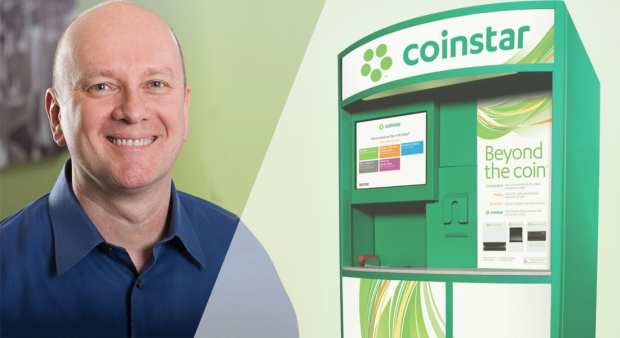Coinstar CEO On The Ongoing Journey To Digitize Cash (And Turn It Into Crypto)

The great digital shift, along with the pandemic, has brought all manner of activities into the virtual realm — most notably, of course, commerce itself.
To that end, as Coinstar CEO Jim Gaherity told PYMNTS, the stage is becoming increasingly set for currency — the literal cold, hard stuff of bills and coins — to be rendered in bits and bytes.
The evolution — beyond sorting coins stored in proverbial piggy banks and coffee cans and toward bill pay and commerce, all in a self-service environment — is a natural one for the firm, which traces its evolution back 29 years with initial installations in groceries. Coinstar now owns and operates more than 22,000 kiosks across nine countries and recycles roughly $3 billion in coins annually worldwide ($2.7 billion in the U.S. alone).
You likely know the drill: Where once we separated quarters, pennies and nickels, and painstakingly bundled them in paper wrappers, and lugged them to the bank for redemption, consumers can bring loose change to a Coinstar kiosk, dump the coins in, have them counted automatically … and then decide how they want those funds to be used. (Coinstar charges a fee to turn coins into cash.)
Gaherity recounted to PYMNTS that through the past few decades, Coinstar has broadened its reach and scope through partnerships beyond its initial product that focused on e-gift card products and charitable donations.
That original market niche was tied to the premise that loose change, if not needed by consumers to make ends meet, could be steered toward charities such as the American Red Cross, the World Wildlife Foundation and a host of others.
“We became a professional fundraiser for many charities across the U.S.,” he said.
Fast forward to today, and technology has helped play a role in helping Coinstar embrace new offerings and use cases, spanning paper vouchers for cash, or eGift cards for Amazon and Starbucks, among others; and in terms of mechanics, Gaherity said, in the case of eGift cards it is the product partner, not the end-user, who pays the fee.
“We’ve also embedded bar codes on our vouchers so that consumers can use them at checkout to pay for their groceries if they so choose and put that value toward the purchase of bread and milk and other sundries,” said Gaherity.
More recent and current trends have created tailwinds for Coinstar to pivot toward and embrace the great digital shift that has been the hallmark of the pandemic.
“Consumers are migrating to … this digital world that we live in for payments,” he said, adding that Coinstar’s strategy has given rise to the ability for consumer to come in and load cash onto a digital payment platform, including cryptocurrencies (purchased though mobile phones and apps at the kiosk).
Consumers, he said can buy bitcoin today through its back-end partners that manage digital wallets for the consumer.
In the current environment, of course, the pandemic decimated foot traffic across any number of verticals — restaurants and retailers come to mind, of course. But as Gaherity noted, grocery traffic has hit an inflection point, and foot traffic, after being down 50 percent at the nadir, has been down a relatively muted 20 percent.
“With the reduction in foot traffic, we had had a reduction in volume,” said Gaherity. “It has not been significant. What we have seen increased significantly is the bitcoin purchases. In fact, our bitcoin sales on our machines have increased dramatically week over week for the last 10 to 12 weeks,” amid an online and in-store advertising boost.
Gaherity said the firm, which has more than 4,500 kiosks integrated with Coinme APIs to facilitate the ability to buy bitcoin, is examining ways to bring that functionality onto an international stage, likely beginning in Europe.
Bill Payment And Commerce
With a nod toward more traditional financial services, Coinstar, he said, has been building relationships with other digital platforms to bring cash onboard to enable individuals to deposit funds in bank accounts (Coinstar kiosks are also on site at credit unions and savings and loan institutions). If consumers have accounts with a particular bank, they can pour coins into the kiosk and conduct a direct-to-account bank deposit.
Coinstar is also branching out into online gambling and bill payment services, he said. On the latter front, Gaherity said embracing bill payments serves a way to meet the needs of the unbanked and underbanked population that numbers more than 85 million consumers.
As he noted to PYMNTS, “there are people who just enjoy using cash because of its anonymity and lack of being able to be tracked.”
Taking paper and hard currencies and bringing them into the digital world in an effort to manage daily financial life is illustrated by Coinstar’s partnerships with a number of institutions to enable consumers to make cash payments for a variety of bills, rent and subscription services.
The firm’s partnership with Amazon leveraged phone numbers, Amazon accounts and cash to build balances to enable underbanked users to participate more fully in eCommerce.
The Brick-And-Mortar Component
In expanding cash-to-digital payment initiatives, kiosk placement is critical, of course. At a high level, that means getting Coinstar kiosks situated near or even in the entrance of high-traffic grocers, pharmacies, retailers and financial institutions. Gaherity said the revenue-share model is particularly attractive to the operators that choose to install Coinstar kiosks.
“The fees that we’re paying them — that revenue share helps to offset some of the float that they have for redemption of vouchers,” he said. “If you think about the roughly 3 square feet of space that kiosk takes up, they could be putting something else there — firewood or dog food — but our profit per square foot is pretty impressive to a grocery store.”
Looking ahead, Gaherity said, Coinstar could create a Coinstar digital wallet that would be used at the kiosk to move cash for bill payments, remittances or even P2P transactions.
“That wallet will enable consumers to load cash at the kiosk onto a wallet and then decide how to use those funds, across a variety of payment, savings and investing options, including using those funds in retail with a general purpose reloadable card,” he said.
As Gaherity told PYMNTS, “We’re becoming more and more about turning coins and paper money into digital money — acting as an ‘on-ramp’ for fiat currency into that digital world.”
